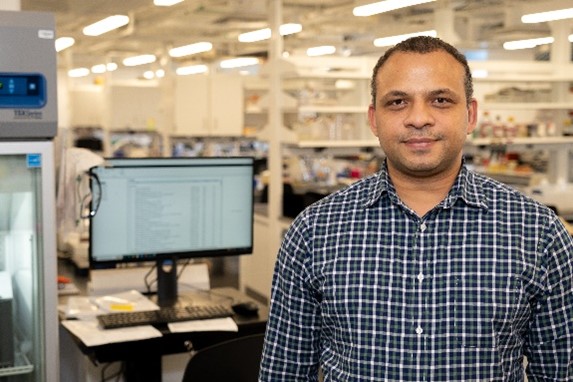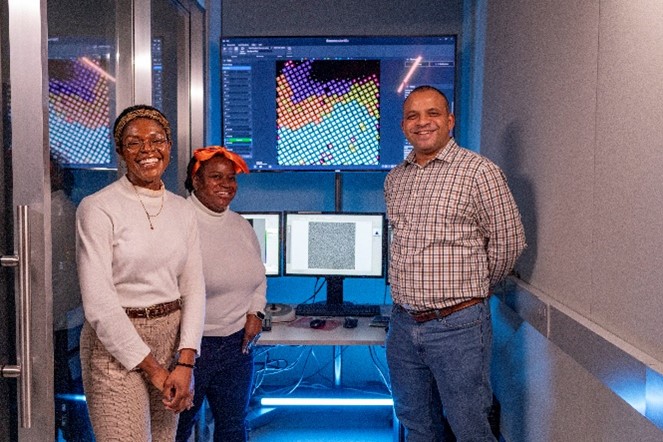
“I think it’s really an exciting time for science. Some people might think that everything out there to be discovered has already been discovered, but that’s far from the truth. There is still much, much more to discover,” says John Jimah, Ph.D., an assistant professor of molecular biology at Princeton University in Princeton, New Jersey. We talked with him about how he moved internationally to pursue his career, how his current research on cell membranes could help treat malaria, and how science holds space for everyone.
Get to Know Dr. Jimah
- Books or movies? Movies
- Coffee or tea? Mocha
- Beach or mountains? Beach
- Cats or dogs? Dogs
- Music, podcasts, or quiet? Podcasts
- Early bird or night owl? Early bird
- Childhood dream job? Judge
- Favorite hobby? Bicycling
- Favorite piece of lab safety equipment? Gloves
- A scientist (past or present) you’d like to meet? Leonardo da Vinci
Q: How did you first become interested in science?
A: I spent my childhood in the upper regions of Ghana in West Africa. It was a wonderful place to grow up, but there were many challenges there too. While I was in elementary school, there was an outbreak of meningitis. It was scary and caused some of my schoolmates to pass away. But I learned that we could get vaccinations, which protected us from the disease and put everyone at ease. I became curious about how the vaccines worked, and I think that’s what really drew me into science. I saw that understanding the natural world—which is exciting on its
own—can have very important impacts on health.
Q: How did you start your path to a research career?
A: When I was going through the Ghanaian educational system, you had to choose what to focus on starting in high school. I chose the science track. From what I was reading, I knew that a lot of the cutting-edge science was being done in the United States and Europe, so I wanted to go to college in the United States. Had I stayed in Ghana, the track I was on would have taken me to professional school, such as medical or engineering school, but I wanted to have a broader knowledge of things.
I came to the United States for college at Colgate University in Hamilton, New York. That was a wonderful experience because it was a college focused on undergraduate teaching, so I really got to learn how to think critically about not only science but also other topics. For example, I went on a short-term study abroad to learn how the Danish health care and social service systems work. My undergraduate experience really cemented my interest in science and gave me a strong foundation in molecular biology.
Q: What were your next steps in science?
A: After graduating, I worked as a research technician for a few years to gain some financial independence and research experience to really be sure that was the path I wanted to take. I then moved on to a Ph.D. program at Washington University in St. Louis, Missouri, where I was able to do what I always wanted to do: work towards a malaria vaccine. This research introduced me to the world of structural biology, and that’s just a fascinating field. It focuses on taking pictures of proteins and molecular machines from cells in atomic detail. You see exactly what they look like, which tells you how they work. I used a structural biology technique called X-ray crystallography to understand what the malaria parasite proteins look like to determine how we could get the human immune system to generate antibodies against those proteins.
Then I moved on to postdoctoral work (postdoc) at the National Institute of Diabetes and Digestive and Kidney Diseases, where my skills and interest in structural biology developed further using a method called cryo-electron microscopy (cryo-EM). It’s similar to light microscopy but uses electrons in place of light. Cryo-EM also allows you to see how proteins and other molecules in cells look and how they might function. After the postdoc, I began my current position as an assistant professor at Princeton University.
Q: What is your lab researching?

A: My lab focuses on how the outer barriers of cells, called membranes, break apart and come together—a process called remodeling. For example, we’re studying endocytosis, which is how cells take up substances from the outside for nutrition or communication. Typically, during endocytosis the membrane creates a compartment that acts like an elevator to take the substance into the cell. This elevator carrying the substance must break off from the membrane, and we’re studying the proteins involved in that process. We do so by identifying the proteins of interest and then taking pictures of them with an electron microscope.
We’re studying endocytosis in human cells and malaria parasites, which live in human cells and take nutrients from them. Learning about the proteins in malaria parasites involved in endocytosis could help us find targets for antiparasitic medicines. In human cells, we’re investigating how we can make endocytosis faster or slower because it’s a very important process and is involved in the uptake of medicines.
Q: What types of challenges did you face in your career path?
A: I didn’t realize some of the challenges I encountered were challenges until much later. For example, before coming to the United States, I’d never typed a paper or used PowerPoint for a presentation. As an undergraduate, I worked as a computer helpdesk technician, and that job allowed me to gain skills in using Microsoft Word and PowerPoint. When I’d encounter a challenge, I would either figure out a way to deal with it or talk to peers or advisors about how to overcome it.
Q: How has NIGMS supported your career?
A: During my postdoc, I became one of the first scholars in the NIGMS Maximizing Opportunities for Scientific and Academic Independent Careers (MOSAIC) program, which has been really influential in my career. My MOSAIC grant supported my postdoc research and is also funding my first years as a faculty member. The unique thing about MOSAIC is that scholars get to interact with, learn from, and share experiences with one another. We also get to work with scientific societies. I’m part of a group with the American Society for Biochemistry and Molecular Biology, and that’s just wonderful because I get to connect with amazing scientists there and meet researchers of all levels at conferences and events. I’ve also received career development training for how to be an effective mentor for people from different backgrounds.
The NIGMS-supported national cryo-EM centers also stand out to me. My lab does a lot of cryo-EM, and it’s fantastic that NIGMS supports the centers to make this technique accessible to scientists all across the country. At Princeton, we’re lucky to have a lot of cryo-EM equipment, but it’s still helpful to have the training, resources, and expertise at national centers that we can tap into.
Q: What do you consider to be your biggest accomplishment?
A: I think my biggest accomplishment, which is an ongoing one, is building a laboratory team that’s creative, innovative, and inclusive. Science is such a big field, and I think everyone has something to contribute to it—no matter what skills they have. For example, if you’re a good artist, you can create images that bring scientific processes to life; or if you’re good at mathematics, you might excel at seeing patterns in data or making models to explain processes.
The opportunity to create a lab environment where everyone, from undergraduates to postdoctoral researchers, can make discoveries is thrilling. In the past, I would make a discovery and see something for the first time, but now all the people in my group come to me with their results. It’s really exciting to see what they’re discovering and the new skills they’re learning.
Dr. Jimah’s research is supported by the NIGMS MOSAIC program through grant R00GM140220.







